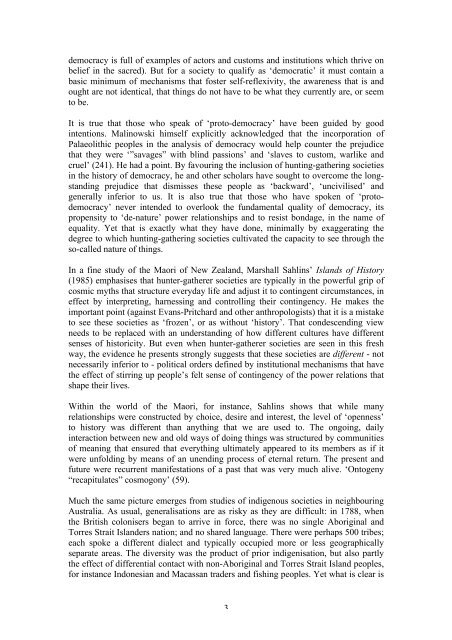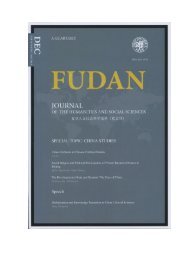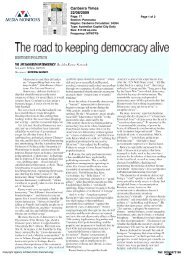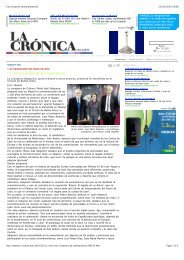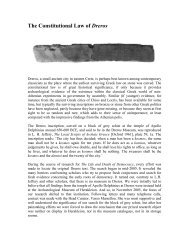Campfire Democracy? - The Life And Death Of Democracy
Campfire Democracy? - The Life And Death Of Democracy
Campfire Democracy? - The Life And Death Of Democracy
You also want an ePaper? Increase the reach of your titles
YUMPU automatically turns print PDFs into web optimized ePapers that Google loves.
democracy is full of examples of actors and customs and institutions which thrive on<br />
belief in the sacred). But for a society to qualify as ‘democratic’ it must contain a<br />
basic minimum of mechanisms that foster self-reflexivity, the awareness that is and<br />
ought are not identical, that things do not have to be what they currently are, or seem<br />
to be.<br />
It is true that those who speak of ‘proto-democracy’ have been guided by good<br />
intentions. Malinowski himself explicitly acknowledged that the incorporation of<br />
Palaeolithic peoples in the analysis of democracy would help counter the prejudice<br />
that they were ‘”savages” with blind passions’ and ‘slaves to custom, warlike and<br />
cruel’ (241). He had a point. By favouring the inclusion of hunting-gathering societies<br />
in the history of democracy, he and other scholars have sought to overcome the longstanding<br />
prejudice that dismisses these people as ‘backward’, ‘uncivilised’ and<br />
generally inferior to us. It is also true that those who have spoken of ‘protodemocracy’<br />
never intended to overlook the fundamental quality of democracy, its<br />
propensity to ‘de-nature’ power relationships and to resist bondage, in the name of<br />
equality. Yet that is exactly what they have done, minimally by exaggerating the<br />
degree to which hunting-gathering societies cultivated the capacity to see through the<br />
so-called nature of things.<br />
In a fine study of the Maori of New Zealand, Marshall Sahlins’ Islands of History<br />
(1985) emphasises that hunter-gatherer societies are typically in the powerful grip of<br />
cosmic myths that structure everyday life and adjust it to contingent circumstances, in<br />
effect by interpreting, harnessing and controlling their contingency. He makes the<br />
important point (against Evans-Pritchard and other anthropologists) that it is a mistake<br />
to see these societies as ‘frozen’, or as without ‘history’. That condescending view<br />
needs to be replaced with an understanding of how different cultures have different<br />
senses of historicity. But even when hunter-gatherer societies are seen in this fresh<br />
way, the evidence he presents strongly suggests that these societies are different - not<br />
necessarily inferior to - political orders defined by institutional mechanisms that have<br />
the effect of stirring up people’s felt sense of contingency of the power relations that<br />
shape their lives.<br />
Within the world of the Maori, for instance, Sahlins shows that while many<br />
relationships were constructed by choice, desire and interest, the level of ‘openness’<br />
to history was different than anything that we are used to. <strong>The</strong> ongoing, daily<br />
interaction between new and old ways of doing things was structured by communities<br />
of meaning that ensured that everything ultimately appeared to its members as if it<br />
were unfolding by means of an unending process of eternal return. <strong>The</strong> present and<br />
future were recurrent manifestations of a past that was very much alive. ‘Ontogeny<br />
“recapitulates” cosmogony’ (59).<br />
Much the same picture emerges from studies of indigenous societies in neighbouring<br />
Australia. As usual, generalisations are as risky as they are difficult: in 1788, when<br />
the British colonisers began to arrive in force, there was no single Aboriginal and<br />
Torres Strait Islanders nation; and no shared language. <strong>The</strong>re were perhaps 500 tribes;<br />
each spoke a different dialect and typically occupied more or less geographically<br />
separate areas. <strong>The</strong> diversity was the product of prior indigenisation, but also partly<br />
the effect of differential contact with non-Aboriginal and Torres Strait Island peoples,<br />
for instance Indonesian and Macassan traders and fishing peoples. Yet what is clear is<br />
3


